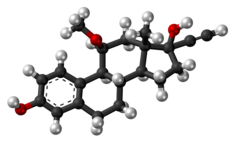 | |
 | |
| Clinical data | |
|---|---|
| Trade names | Surestryl |
| Other names | R-2858, RU-2858, NSC-118191; 11β-Methoxy-17α-ethynylestradiol; 11β-MeO-EE 11β-Methoxy-17α-ethynylestra-1,3,5(10)-triene-3,17β-diol |
| Pregnancy category |
|
| Routes of administration | By mouth |
| Drug class | Estrogen; Estrogen ether |
| ATC code | |
| Legal status | |
| Legal status |
|
| Pharmacokinetic data | |
| Bioavailability | 33%[1] |
| Protein binding | Minimal[1] |
| Metabolism | Liver[2] |
| Elimination half-life | 8.2 hours[1] |
| Identifiers | |
| |
| CAS Number | |
| PubChem CID | |
| ChemSpider | |
| UNII | |
| KEGG | |
| ChEBI | |
| ChEMBL | |
| CompTox Dashboard (EPA) | |
| Chemical and physical data | |
| Formula | C21H26O3 |
| Molar mass | 326.436 g·mol−1 |
| 3D model (JSmol) | |
| |
| |
Moxestrol, sold under the brand name Surestryl, is an estrogen medication which has been used in Europe for the treatment of menopausal symptoms and menstrual disorders.[3][4][2][5][6] It is taken by mouth.[6] In addition to its use as a medication, moxestrol has been used in scientific research as a radioligand of the estrogen receptor.[7]
- ^ a b c Salmon J, Coussediere D, Cousty C, Raynaud JP (August 1983). "Pharmacokinetics and metabolism of moxestrol in animals--rat, dog and monkey". Journal of Steroid Biochemistry. 19 (2): 1223–1234. doi:10.1016/0022-4731(83)90421-1. PMID 6887930.
- ^ a b Li JJ, Nandi S, Li SA (6 December 2012). Hormonal Carcinogenesis: Proceedings of the First International Symposium. Springer Science & Business Media. pp. 184–. ISBN 978-1-4613-9208-8.
- ^ Elks J (14 November 2014). The Dictionary of Drugs: Chemical Data: Chemical Data, Structures and Bibliographies. Springer. pp. 841–. ISBN 978-1-4757-2085-3.
- ^ Morton IK, Hall JM (31 October 1999). Concise Dictionary of Pharmacological Agents: Properties and Synonyms. Springer Science & Business Media. pp. 186–. ISBN 978-0-7514-0499-9.
- ^ Nunn AD (19 June 1992). Radiopharmaceuticals: Chemistry and Pharmacology. CRC Press. pp. 342–. ISBN 978-0-8247-8624-3.
- ^ a b William Martindale; Royal Pharmaceutical Society of Great Britain. Dept. of Pharmaceutical Sciences (1993). The Extra Pharmacopoeia. Pharmaceutical Press. p. 1188. ISBN 978-0-85369-300-0.
Moxestrol is a synthetic oestrogen with actions and uses similar to thosre described for the oestrogens in general. Moxestrol is reponed to have a prolonged duration of action. It has been given by mouth in the treatment of menopausal, postmenopausal, and menstrual symptoms. Dose have ranged from 50 to 100 μg weekly for long-term therapy to 25 to 250 μg daily for short-term use.
- ^ Raynaud JP, Martin PM, Bouton MM, Ojasoo T (September 1978). "11beta-Methoxy-17-ethynyl-1,3,5(10)-estratriene-3,17beta-diol (moxestrol), a tag for estrogen receptor binding sites in human tissues". Cancer Research. 38 (9): 3044–3050. PMID 679210.